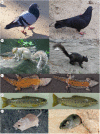Melanin-based coloration and host-parasite interactions under global change
- PMID: 29848644
- PMCID: PMC5998088
- DOI: 10.1098/rspb.2018.0285
Melanin-based coloration and host-parasite interactions under global change
Abstract
The role of parasites in shaping melanin-based colour polymorphism, and the consequences of colour polymorphism for disease resistance, remain debated. Here we review recent evidence of the links between melanin-based coloration and the behavioural and immunological defences of vertebrates against their parasites. First we propose that (1) differences between colour morphs can result in variable exposure to parasites, either directly (certain colours might be more or less attractive to parasites) or indirectly (variations in behaviour and encounter probability). Once infected, we propose that (2) immune variation between differently coloured individuals might result in different abilities to cope with parasite infection. We then discuss (3) how these different abilities could translate into variable sexual and natural selection in environments varying in parasite pressure. Finally, we address (4) the potential role of parasites in the maintenance of melanin-based colour polymorphism, especially in the context of global change and multiple stressors in human-altered environments. Because global change will probably affect both coloration and the spread of parasitic diseases in the decades to come, future studies should take into account melanin-based coloration to better predict the evolutionary responses of animals to changing disease risk in human-altered environments.
Keywords: animal coloration; disease risk; host–parasite interactions; immunity; melanin pigments; sexual selection.
© 2018 The Author(s).
Conflict of interest statement
The authors declare no competing interests.
Figures



References
-
- Jacquin L, Gauthey Z, Roussille V, Le Hénaff M, Tentelier C, Labonne J. 2017. Brown trout colouration reflects alternative reproductive strategies in variable environments. Behav. Ecol. 28, 1423–1434. (10.1093/beheco/arx102) - DOI
Publication types
MeSH terms
Substances
Associated data
LinkOut - more resources
Full Text Sources
Other Literature Sources
Medical

